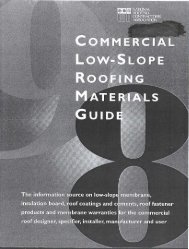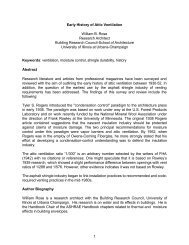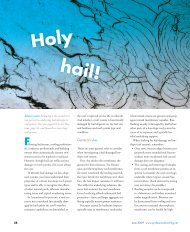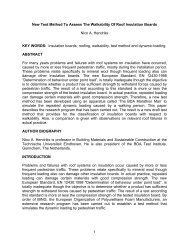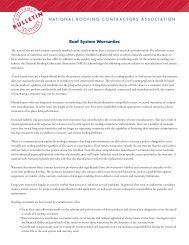Untitled - National Roofing Contractors Association
Untitled - National Roofing Contractors Association
Untitled - National Roofing Contractors Association
Create successful ePaper yourself
Turn your PDF publications into a flip-book with our unique Google optimized e-Paper software.
In providing for drainage, the designer must carefully oonsider<br />
all areas of the roof. Good practice dictates that<br />
there be no pondlng water. For information on deck design<br />
for ponding water conditions, designers may consult<br />
the American Institute of Timber Construdion (AJTC).<br />
the Steel Joist Institute (SJI) or the American Institute of<br />
Steel Construction (AISC). Drainage crickets should be<br />
provided between drains and on the high side of mechanical<br />
curbs to drain these areas. (See NRCA Construction<br />
Details.)<br />
To ensure the proper draining of water in the heaviest<br />
rains. the design of drain sizes and drain placement<br />
should be based on either:<br />
. The requirements of the American <strong>National</strong><br />
Standards Institute (ANSI) Standard A 112.21.2<br />
. Building code requirements or<br />
. Maximum rainfall information of the geographical<br />
area<br />
Drains should be recessed (sumped) below the roof surface,<br />
and sufficient insulation must remain around the<br />
drains to prevent condensation. This is accomplished by<br />
setting the drain head below the level of the insulation<br />
and tapering the insulation down to the drain. (See NRCA<br />
Construction Details.) Regular maintenance should be<br />
performed to prevent clogging of drains. To avoid the<br />
dangers of water buildup from clogged drains, the use<br />
of auxiliary drains or throughwall scuppers is recommended<br />
and, in many cases, is a part of building code<br />
requirements.<br />
VII. EXPANSION JOINTS AND<br />
AREA DIVIDERS<br />
Expansion Joints<br />
Roof expansion joints are used to minimize the effect of<br />
the stresses and movements of a building's components<br />
10<br />
and to prevent these stresses from splitting or ridging<br />
the roof membrane. Joints in the roof assem~ (the term<br />
roof assembly includes the roof deck) must be placed<br />
in the same location as the building's structural expansion<br />
joints (although they may also be required in other<br />
locations, as discussed in this section). Each of a building's<br />
components has varying coefficients of expansion<br />
and contraction, and each of them is subjeded to varying<br />
temperature changes. In the design and placement<br />
of expansion joints, the designer should consider:<br />
. The thermal movement characteristics of the<br />
building<br />
. The structural roof deck<br />
. The roof membrane selected<br />
. The climatic conditions to be encountered<br />
Expansion joints must extend across the entire width of<br />
the roof; they must never terminate short of the roof edge<br />
or perimeter. They should be designed to accommodate<br />
contraction as well as expansion. The expansion joint<br />
should be detailed and constructed to a raised (nominal)<br />
height of 8 inches above the roof line. (See NRCA Construction<br />
Details.) Water drainage should NEVER be attempted<br />
through or over an expansion joint.<br />
Roof expansion joints should always be provided at the<br />
following locations:<br />
. Where expansion or contraction joints are provided<br />
in the structural system<br />
. Where steel framing, structural steel or decking<br />
change direction<br />
. Where separate wings of "L," "U," "T" or similar<br />
configurations exist<br />
. Where the type of decking changes; for example,<br />
where a precast concrete deck and a steel deck<br />
abut<br />
. Whenever additions are connected to existing<br />
buildings<br />
. At junctions where interior heating conditions<br />
11




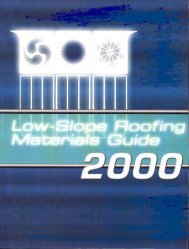
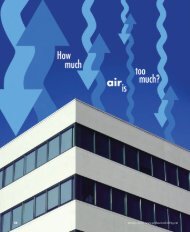

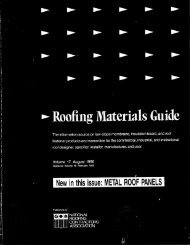
![Wm] - National Roofing Contractors Association](https://img.yumpu.com/36696816/1/190x245/wm-national-roofing-contractors-association.jpg?quality=85)

